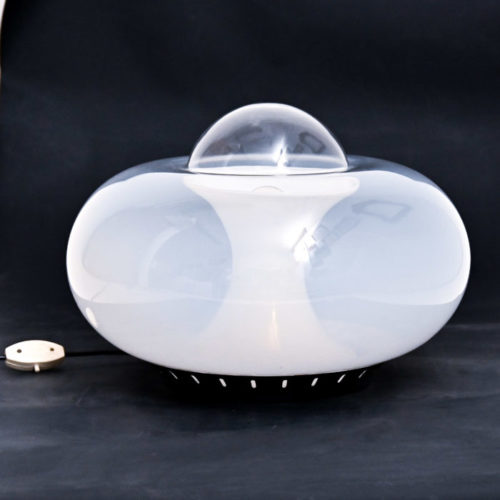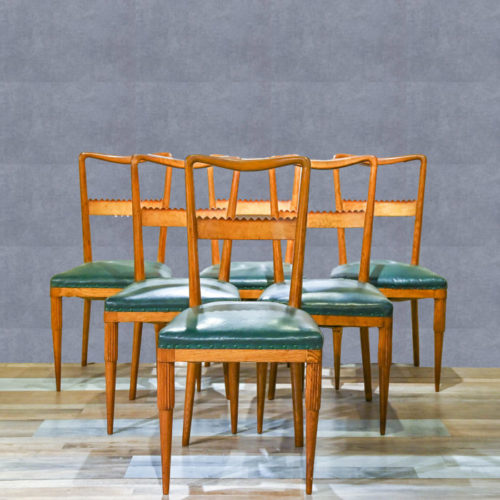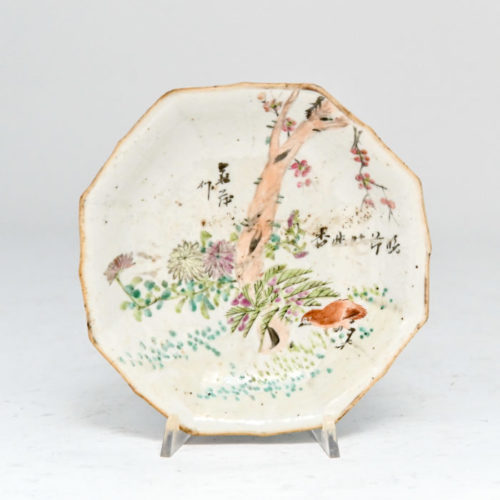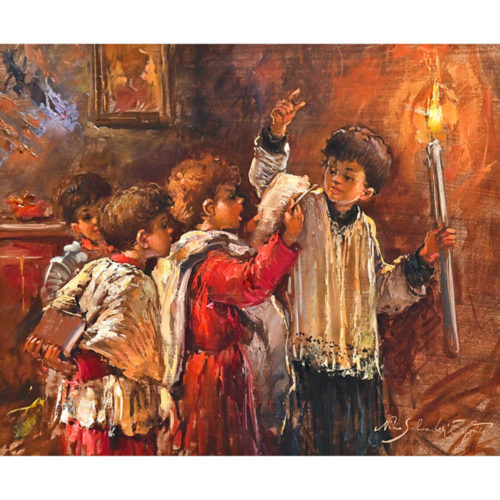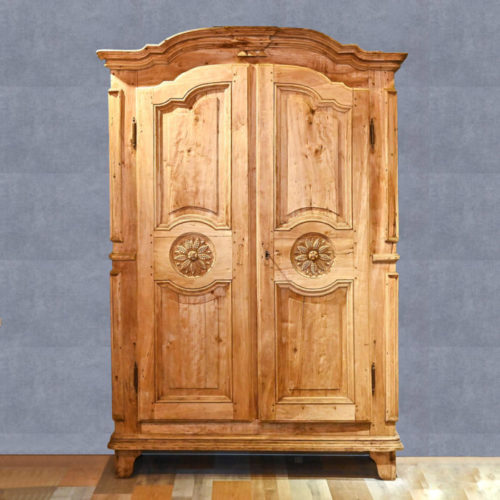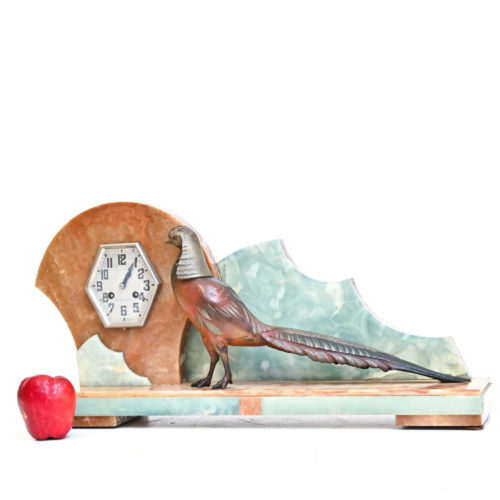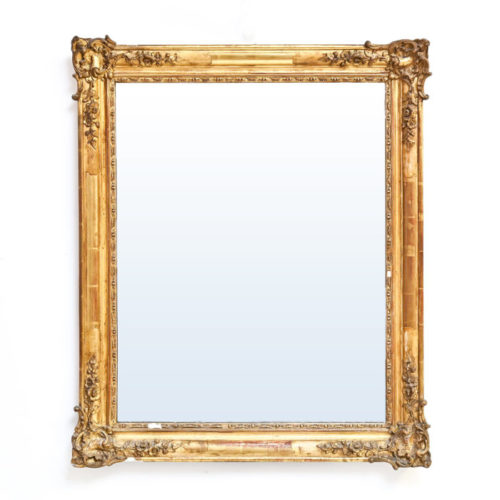-
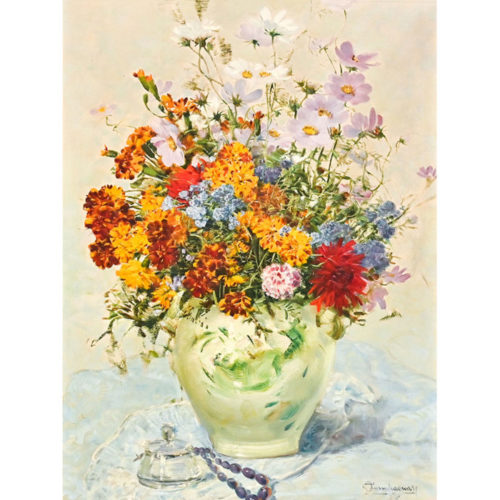 "Still life of flowers" oil on canvas from the 1950s by Ottorino Campagnari. Ottorino Campagnarini (Mestre 1910 - Turin 1987), studied painting at the art school in Mestre, under the professor Giuseppe Urbani. Settled in Turin in 1935, since 1940 he had exhibited regularly at the National Quadrennial of Art of the Promoter of Fine Arts in Turin, at the Gazzetta del Popolo cultural artist, at the Circolo degli Artisti in Turin. He also exhibited in group exhibitions: in Washington, Chicago, London, Turin, Naples, Milan, Rome etc. Personal exhibitions in Turin (Galleria Martina), Imperia, Milan (Galleria Bolzani), Valle d'Aosta, Gressoney-St. Jean (Palazzo Municipio) etc. He has had prizes in competitions and impromptu. Period: 1950s Measurements: In frame H 98 x W 77 x D 5.5 / Canvas H 80 x W 60 cm
"Still life of flowers" oil on canvas from the 1950s by Ottorino Campagnari. Ottorino Campagnarini (Mestre 1910 - Turin 1987), studied painting at the art school in Mestre, under the professor Giuseppe Urbani. Settled in Turin in 1935, since 1940 he had exhibited regularly at the National Quadrennial of Art of the Promoter of Fine Arts in Turin, at the Gazzetta del Popolo cultural artist, at the Circolo degli Artisti in Turin. He also exhibited in group exhibitions: in Washington, Chicago, London, Turin, Naples, Milan, Rome etc. Personal exhibitions in Turin (Galleria Martina), Imperia, Milan (Galleria Bolzani), Valle d'Aosta, Gressoney-St. Jean (Palazzo Municipio) etc. He has had prizes in competitions and impromptu. Period: 1950s Measurements: In frame H 98 x W 77 x D 5.5 / Canvas H 80 x W 60 cm -
Out of stock
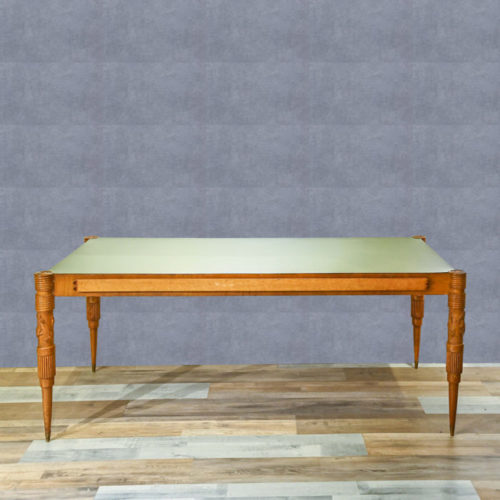 Pier Luigi Colli (1895-1968), table from the 1950s. The table has elegant cylindrical carved legs, it was built in elm, briar and brass; the top is in green formica. The cabinet is in excellent condition. Period: 1950s Measurements: H 77 x W 180 x D 86.5 cm
Pier Luigi Colli (1895-1968), table from the 1950s. The table has elegant cylindrical carved legs, it was built in elm, briar and brass; the top is in green formica. The cabinet is in excellent condition. Period: 1950s Measurements: H 77 x W 180 x D 86.5 cm -
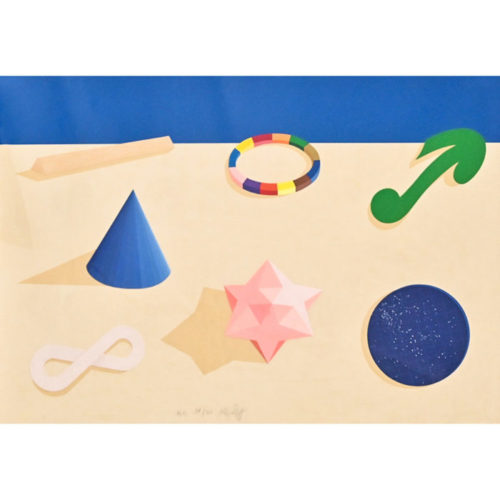 Screen printing and collage on paper by Lucio Del Pezzo, limited edition of only 20 copies. In excellent condition. Lucio Del Pezzo (Naples 1933 - Milan 2020) was an Italian artist, painter and sculptor. He is one of the founders of “Gruppo 58”, which has always been very close to other avant-gardes, such as Enrico Baj's Nuclear Movement, the Spoor Movement of Monaco, Phases of Paris and Boa of Buenos Aires. His works from the period 1958-1960 featured assemblages of various objects, including fragments of popular prints and images. In 1960 he moved to Paris, then to Milan, where several monographic exhibitions have been dedicated to him. The first one dates back to 1974. Starting from 1962 Del Pezzo has created his typical repertoire of "paintings" or "sculptures", made of monochrome geometric panels, on which shelves or hollowed out concavities are inserted, which support regular geometric objects, sometimes very colorful. Lucio del Pezzo's production focuses on the use of common objects that, enriched with different materials, cross the boundary between painting and sculpture. His style is also characterized by a rapprochement with metaphysical atmospheres, while the playful sense and irony behind each work is inspired by the Dadaist movement. Period: 1970s Measurements: In frame H 73 x W 103 x D 3.5 / Serigraphy H 70 x W 100 cm
Screen printing and collage on paper by Lucio Del Pezzo, limited edition of only 20 copies. In excellent condition. Lucio Del Pezzo (Naples 1933 - Milan 2020) was an Italian artist, painter and sculptor. He is one of the founders of “Gruppo 58”, which has always been very close to other avant-gardes, such as Enrico Baj's Nuclear Movement, the Spoor Movement of Monaco, Phases of Paris and Boa of Buenos Aires. His works from the period 1958-1960 featured assemblages of various objects, including fragments of popular prints and images. In 1960 he moved to Paris, then to Milan, where several monographic exhibitions have been dedicated to him. The first one dates back to 1974. Starting from 1962 Del Pezzo has created his typical repertoire of "paintings" or "sculptures", made of monochrome geometric panels, on which shelves or hollowed out concavities are inserted, which support regular geometric objects, sometimes very colorful. Lucio del Pezzo's production focuses on the use of common objects that, enriched with different materials, cross the boundary between painting and sculpture. His style is also characterized by a rapprochement with metaphysical atmospheres, while the playful sense and irony behind each work is inspired by the Dadaist movement. Period: 1970s Measurements: In frame H 73 x W 103 x D 3.5 / Serigraphy H 70 x W 100 cm -
Out of stock
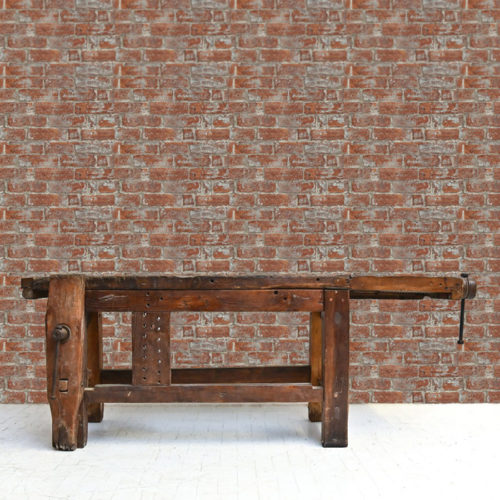 Carpenter's bench from the end of the 19th century, in larch, with double vice. Period: End of the 19th century Measurements: Flat net L 209 x H 81 x P 70 / With clamps L 217 x H 81 x P 83 cm
Carpenter's bench from the end of the 19th century, in larch, with double vice. Period: End of the 19th century Measurements: Flat net L 209 x H 81 x P 70 / With clamps L 217 x H 81 x P 83 cm -
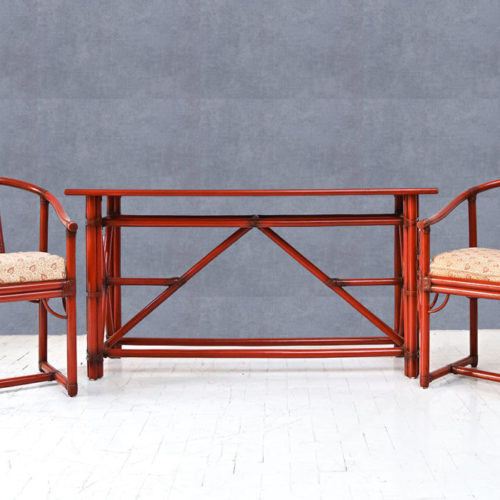 Italo Gasparucci table with pair of chairs, 1970s. In ashwood and lacquered bamboo. They are in excellent condition with slight signs of wear. Period: 1970s Measurements: Table H 75 x L 142 x P46.5 cm; Chairs H 79 x W 48 x D 45 / H seat 42 cm ts: Flat net L 209 x H 81 x P 70 / With clamps L 217 x H 81 x P 83 cm
Italo Gasparucci table with pair of chairs, 1970s. In ashwood and lacquered bamboo. They are in excellent condition with slight signs of wear. Period: 1970s Measurements: Table H 75 x L 142 x P46.5 cm; Chairs H 79 x W 48 x D 45 / H seat 42 cm ts: Flat net L 209 x H 81 x P 70 / With clamps L 217 x H 81 x P 83 cm -
Out of stock
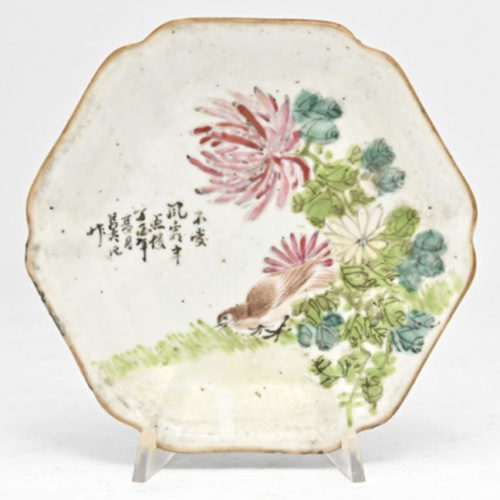 One of six antique ceramic saucers / backsplashes, China, from the early 1900s. Period: Early 1900s Measurements: H 15.5 x W 16.5 x D 4 cm
One of six antique ceramic saucers / backsplashes, China, from the early 1900s. Period: Early 1900s Measurements: H 15.5 x W 16.5 x D 4 cm -
Out of stock
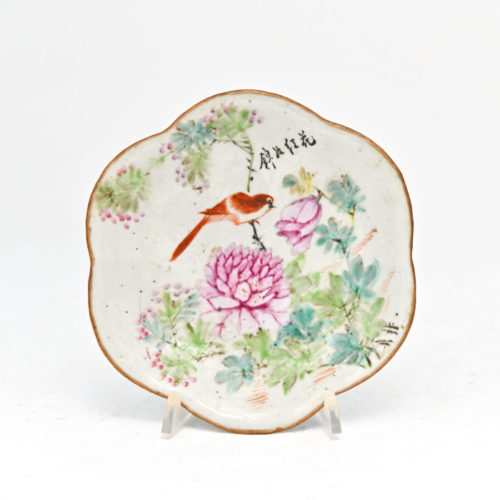 One of six antique ceramic saucers / backsplashes, China, from the early 1900s. Period: Early 1900s Measurements: H 15 x W 16.5 x D 4 cm
One of six antique ceramic saucers / backsplashes, China, from the early 1900s. Period: Early 1900s Measurements: H 15 x W 16.5 x D 4 cm -
Out of stock
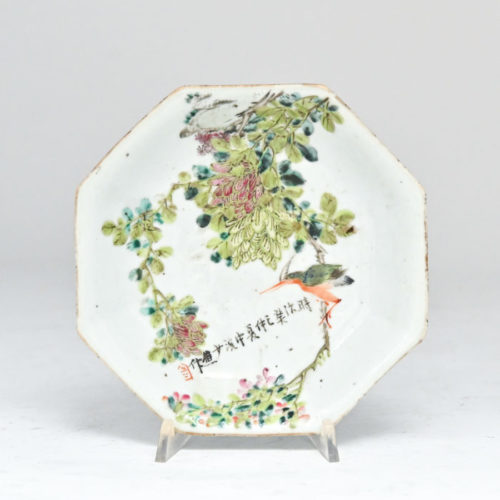 One of six antique ceramic saucers / backsplashes, China, from the early 1900s. Period: Early 1900s Measurements: H 16 x W 16 x D 4.5 cm
One of six antique ceramic saucers / backsplashes, China, from the early 1900s. Period: Early 1900s Measurements: H 16 x W 16 x D 4.5 cm -
Out of stock
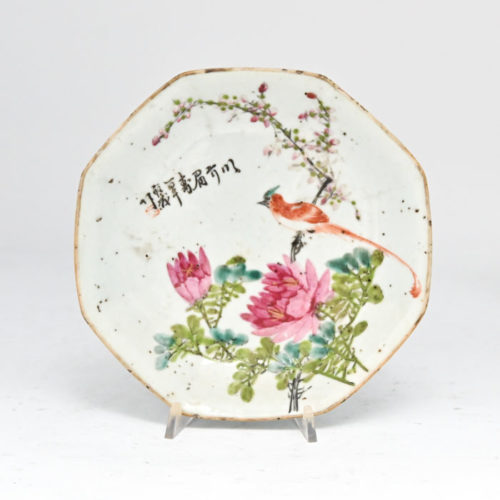 One of six antique ceramic saucers / backsplashes, China, from the early 1900s. Period: Early 1900s Measurements: H 19.5 x W 20 x D 4.5 cm
One of six antique ceramic saucers / backsplashes, China, from the early 1900s. Period: Early 1900s Measurements: H 19.5 x W 20 x D 4.5 cm -
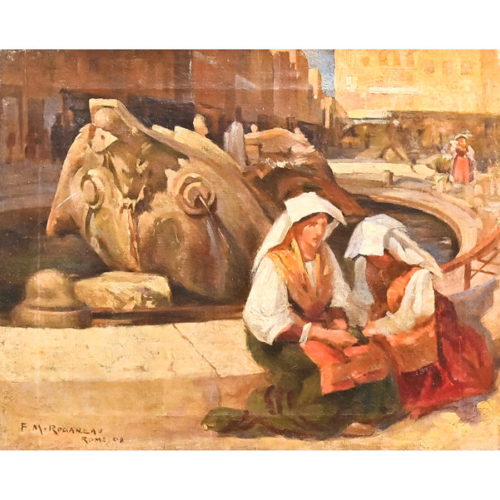 "Women in Piazza di Spagna, at the Fontana della Barcaccia, Rome" oil on canvas by the French painter François Maurice Roganeau. Work signed and dated F. M. Roganeau Rome 1908. Francis Maurice Roganeau (Bordeaux 1883 - Aix-en-Provence 1973) is a French painter, illustrator and sculptor. François-Maurice Roganeau was student of the renowned sculptors Gaston Veuvenot Leroux and Paul Quinsac at the School of Fine Arts in Bordeaux, then he went to study in Jean-Léon Gérôme's studio and later on with Gabriel Ferrier at the Beaux-Arts in Paris. He started with illustration and painting. As an illustrator, he mainly worked for the publisher Henri Laurens. In 1906 he won the first Grand Prix of Rome in painting and the second Grand Prix of sculpture. He exhibited at the 1912 Salon and received a medal for his he painting Le Soir, à la Rivière, inspired by one of André Chénier's Poésies antiques. In 1917 he was commissioned to repair the identical ceiling of the Grand Théâtre de Bordeaux, initially painted by Jean-Baptiste-Claude Robin. He also supplied colored glass boxes to the master glassmaker Gustave Pierre Dagrant, such as the one in the stained glass window of the church of Castillon-la-Bataille. He was director of the Bordeaux School of Fine Arts from 1929 to 1958. In 1932 he was made a Knight of the Legion of Honor. His latest works depict the Basque Country, its people and its landscapes. Period: 1908 Measurements: In frame h 54.5 x L 61.5 x D 6 / Canvas 28.5 x L 35.5 cm
"Women in Piazza di Spagna, at the Fontana della Barcaccia, Rome" oil on canvas by the French painter François Maurice Roganeau. Work signed and dated F. M. Roganeau Rome 1908. Francis Maurice Roganeau (Bordeaux 1883 - Aix-en-Provence 1973) is a French painter, illustrator and sculptor. François-Maurice Roganeau was student of the renowned sculptors Gaston Veuvenot Leroux and Paul Quinsac at the School of Fine Arts in Bordeaux, then he went to study in Jean-Léon Gérôme's studio and later on with Gabriel Ferrier at the Beaux-Arts in Paris. He started with illustration and painting. As an illustrator, he mainly worked for the publisher Henri Laurens. In 1906 he won the first Grand Prix of Rome in painting and the second Grand Prix of sculpture. He exhibited at the 1912 Salon and received a medal for his he painting Le Soir, à la Rivière, inspired by one of André Chénier's Poésies antiques. In 1917 he was commissioned to repair the identical ceiling of the Grand Théâtre de Bordeaux, initially painted by Jean-Baptiste-Claude Robin. He also supplied colored glass boxes to the master glassmaker Gustave Pierre Dagrant, such as the one in the stained glass window of the church of Castillon-la-Bataille. He was director of the Bordeaux School of Fine Arts from 1929 to 1958. In 1932 he was made a Knight of the Legion of Honor. His latest works depict the Basque Country, its people and its landscapes. Period: 1908 Measurements: In frame h 54.5 x L 61.5 x D 6 / Canvas 28.5 x L 35.5 cm -
Out of stock
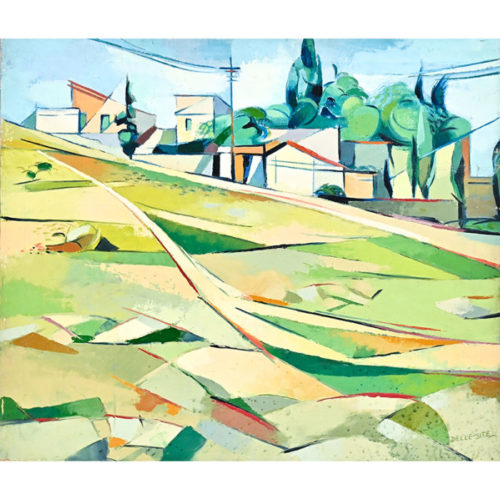 "Landscape on the Via Cassia" oil on canvas by Mino Delle Site. The work is signed at the bottom right Delle Site, listed in the catalog of the IV exhibition of figurative arts of Rome and Lazio, 1963, Galleria SPQR. On the back it has the gallery label. Mino Delle Site (Lecce 1914 - Rome 1996) had first studied in his city and then graduated from the Academy of Fine Arts in Rome. He took part to the Futurist Movement, from which he later broke away in search of new aesthetic expressions. He participated in the First Biennial of Palermo, the Second and Third Quadiennials of Rome and the Venice Biennials of 1934, 1936, 1938. In 1956 he presented in Rome an anthological exhibition summarizing twenty-five years of artistic activity; in 1957 he set up another solo exhibition in Rome, at the Aliberti Gallery; and he also participates in the VI, VII and VIII Roman Quadrennial. In 1965 he exhibited in the USA, at the Rizzoli Gallery in New York with a personal anthological exhibition, works from 1932 to 1965. He won numerous competitions and prizes: in 1936 a prize for Mural Painting; in 1946 a prize for the Female Nude; in 1950 a "Attic" award. He has made decorations and mosaics for public and private entities. His works can be found in both Italian and foreigner public and private collections. Period: 1963 Measurements: H 55 x W 65 x D 1.5 cm
"Landscape on the Via Cassia" oil on canvas by Mino Delle Site. The work is signed at the bottom right Delle Site, listed in the catalog of the IV exhibition of figurative arts of Rome and Lazio, 1963, Galleria SPQR. On the back it has the gallery label. Mino Delle Site (Lecce 1914 - Rome 1996) had first studied in his city and then graduated from the Academy of Fine Arts in Rome. He took part to the Futurist Movement, from which he later broke away in search of new aesthetic expressions. He participated in the First Biennial of Palermo, the Second and Third Quadiennials of Rome and the Venice Biennials of 1934, 1936, 1938. In 1956 he presented in Rome an anthological exhibition summarizing twenty-five years of artistic activity; in 1957 he set up another solo exhibition in Rome, at the Aliberti Gallery; and he also participates in the VI, VII and VIII Roman Quadrennial. In 1965 he exhibited in the USA, at the Rizzoli Gallery in New York with a personal anthological exhibition, works from 1932 to 1965. He won numerous competitions and prizes: in 1936 a prize for Mural Painting; in 1946 a prize for the Female Nude; in 1950 a "Attic" award. He has made decorations and mosaics for public and private entities. His works can be found in both Italian and foreigner public and private collections. Period: 1963 Measurements: H 55 x W 65 x D 1.5 cm -
Out of stock
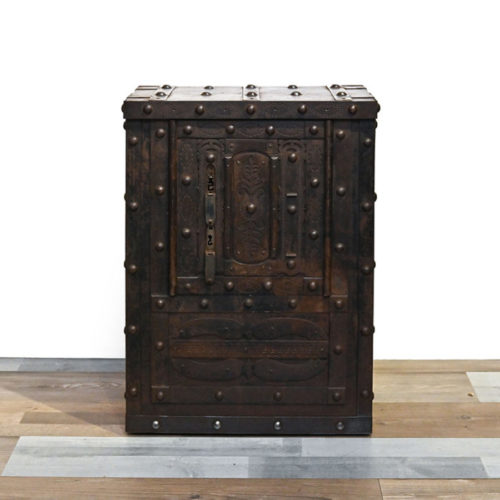 Piedmontese safe from the mid-19th century fully studded, with double lock. Inside there are two wooden drawers. In good condition. Period: Mid 19th century Measurements: H 76 x W 55.5 x D 32 cm
Piedmontese safe from the mid-19th century fully studded, with double lock. Inside there are two wooden drawers. In good condition. Period: Mid 19th century Measurements: H 76 x W 55.5 x D 32 cm -
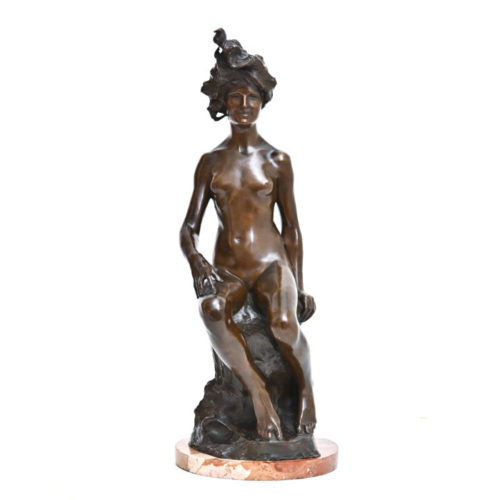 Bronze by Giovanni Nicolini, work of the 1920s / 1930s. Giovanni Nicolini was born in Palermo on April 14, 1872. He died in Rome in 1956. In the 1920s / 1930s the author focused his formal research on the theme of the nude figure, giving life to works strongly expressive of feelings or passions, in which the female figure with floating hair and enveloping shapes revealed a strong art nouveau influence. Period: 1920s / 30s Measurements: H with base 51 cm / H 49 x Ø base 19 cm
Bronze by Giovanni Nicolini, work of the 1920s / 1930s. Giovanni Nicolini was born in Palermo on April 14, 1872. He died in Rome in 1956. In the 1920s / 1930s the author focused his formal research on the theme of the nude figure, giving life to works strongly expressive of feelings or passions, in which the female figure with floating hair and enveloping shapes revealed a strong art nouveau influence. Period: 1920s / 30s Measurements: H with base 51 cm / H 49 x Ø base 19 cm -
Out of stock
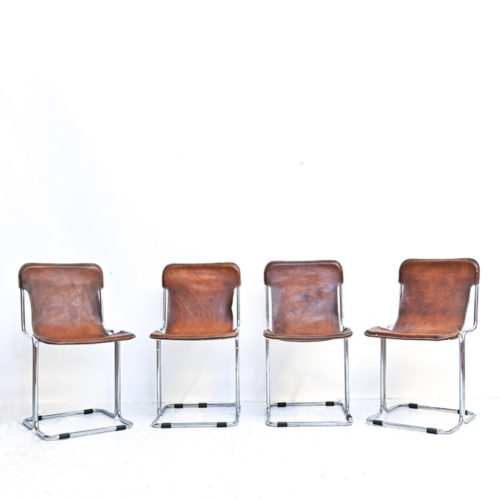 Group of 4 chairs by Antonio Ari Colombo in chromed iron and leather from the 1960s. The leather is in excellent condition, structures to be polished, two screws are missing. Period: 1960s Measurements: H 81 x W 44 x D 50 cm / H seat 46 cm
Group of 4 chairs by Antonio Ari Colombo in chromed iron and leather from the 1960s. The leather is in excellent condition, structures to be polished, two screws are missing. Period: 1960s Measurements: H 81 x W 44 x D 50 cm / H seat 46 cm -
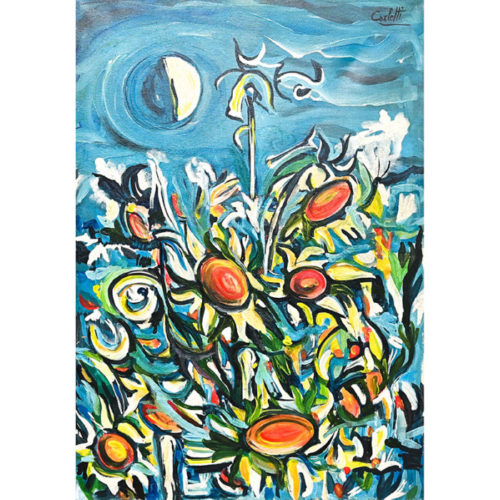 "Flowers and Moon" Oil on canvas by Mario Carletti from the 60s / 70s. Carletti Mario (Turin 1912 - Cossato 1977), a Piedmontese painter and engraver, he painted views, landscapes, portraits and works of sacred art. He exhibited at the Venice Biennale in 1942 and at the Rome Quadriennale in 1956. Period: 60s / 70s Measurements: H 100 x W 70 x D 2 cm
"Flowers and Moon" Oil on canvas by Mario Carletti from the 60s / 70s. Carletti Mario (Turin 1912 - Cossato 1977), a Piedmontese painter and engraver, he painted views, landscapes, portraits and works of sacred art. He exhibited at the Venice Biennale in 1942 and at the Rome Quadriennale in 1956. Period: 60s / 70s Measurements: H 100 x W 70 x D 2 cm -
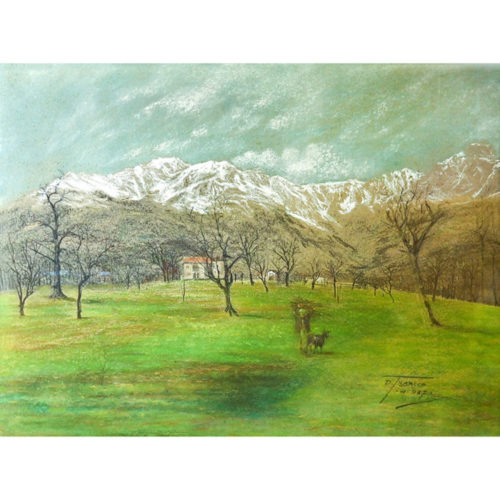 "Biella mountains seen from the Campra plateau" (Graglia) pastel on cardboard by Demetrio Tabacco. Work of March 1937, signed and dated on the lower right. Demetrio Tabacco (Turin 1886 -?) spent some time in the studio of Tommaso Ruffo in Turin. He made his debut in Biella in 1921; he later exhibited his works in Turin, Vercelli, Novara and Tripoli. In this last city he had lived from 1916 to 1918, faithfully portraying types and aspects of environment and manners. He treated landscapes, but he preferred depicting figures. Period: March 1937 Measurements: In frame H 77.5 x W 93.5 cm x D 5.5 / Canvas H 48.5 x W 65.5 cm
"Biella mountains seen from the Campra plateau" (Graglia) pastel on cardboard by Demetrio Tabacco. Work of March 1937, signed and dated on the lower right. Demetrio Tabacco (Turin 1886 -?) spent some time in the studio of Tommaso Ruffo in Turin. He made his debut in Biella in 1921; he later exhibited his works in Turin, Vercelli, Novara and Tripoli. In this last city he had lived from 1916 to 1918, faithfully portraying types and aspects of environment and manners. He treated landscapes, but he preferred depicting figures. Period: March 1937 Measurements: In frame H 77.5 x W 93.5 cm x D 5.5 / Canvas H 48.5 x W 65.5 cm -
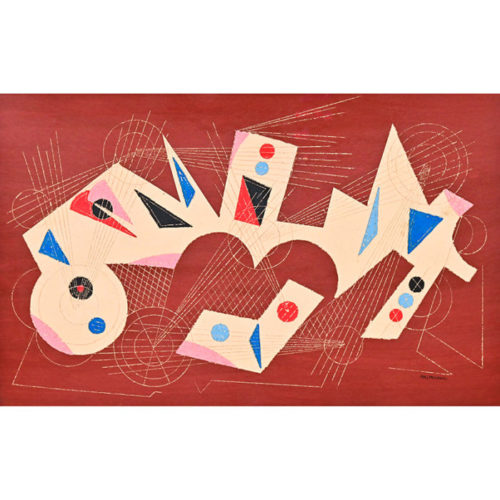 "Composition" by Umberto Mastroianni (Fontana Liri 1910 - Marino 1998), mixed technique / cardboard signed on the lower right, work number 0019. Authentication of the artist on photo. Umberto Mastroianni was born in Fontana Liri, in the province of Frosinone, on 21 September 1910. After his studies at the Academy of San Marcello in Rome, he moved with his family to Turin, continuing his training under the guidance of the master Guerrisi. His first works have a futurist imprinting; in particular he will be influenced by the works of Boccioni which Mastroianni tinges with neo-Cubism. The artist will be the founder of the Turin Prize in 1947 and, during his life, will receive important awards such as the International Grand Prize for Sculpture (Venice Biennale 1958) and the Tokyo Imperial Prize (1989). World famous artist, Umberto Mastroianni died on February 25, 1998 in his house-museum in Marino (Rome), leaving many masterpieces to posterity. Measurements: In frame H 77.5 x W 93.5 cm x D 5.5 / Canvas H 48.5 x W 65.5 cm
"Composition" by Umberto Mastroianni (Fontana Liri 1910 - Marino 1998), mixed technique / cardboard signed on the lower right, work number 0019. Authentication of the artist on photo. Umberto Mastroianni was born in Fontana Liri, in the province of Frosinone, on 21 September 1910. After his studies at the Academy of San Marcello in Rome, he moved with his family to Turin, continuing his training under the guidance of the master Guerrisi. His first works have a futurist imprinting; in particular he will be influenced by the works of Boccioni which Mastroianni tinges with neo-Cubism. The artist will be the founder of the Turin Prize in 1947 and, during his life, will receive important awards such as the International Grand Prize for Sculpture (Venice Biennale 1958) and the Tokyo Imperial Prize (1989). World famous artist, Umberto Mastroianni died on February 25, 1998 in his house-museum in Marino (Rome), leaving many masterpieces to posterity. Measurements: In frame H 77.5 x W 93.5 cm x D 5.5 / Canvas H 48.5 x W 65.5 cm
